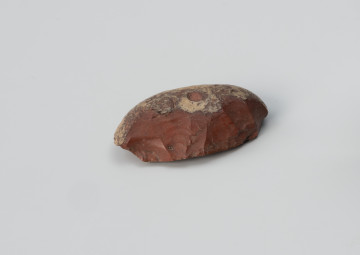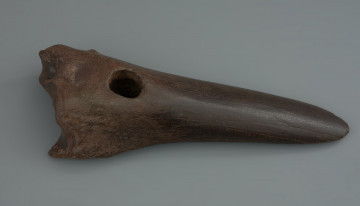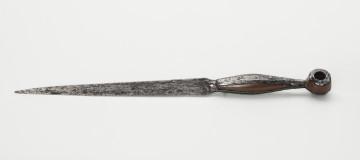
Scraper
7800 p.n.e. — 2000 p.n.e.
National Museum in Szczecin
Part of the collection: Stone Age
Found by a fisherman while fishing in the Baltic Sea near Mrzeźno (West Pomeranian Voivodeship), the auroch skull had lain for many years in the study of Władysław Garczyński (1925-2010), former head of the Department of Archaeology at the National Museum in Szczecin. It formed part of a collection of curiosities from the museum's various departments that he was compiling for his own purposes. The remains of aurochs, extinct, wild ancestors of some breeds of domestic cattle, are extremely rare, and in museum collections of that time, other examples of them were known only from pre-war photographs. The skull from Mrzeźno is preserved in average condition. Most of the facial skull is destroyed, but the braincase and its impressive horns are relatively well preserved, despite the fact that the horns themselves were glued. Noteworthy are the cut marks on the horns, indicating that it came from a hunted animal. The age of the skull can only be estimated at around 9600-4000 BC. The lower limit is marked by the appearance of aurochs in Pomerania at the beginning of the Holocene, while the upper limit is related to the Littorina Sea transgression that flooded large areas of the former southern Baltic coast. This phenomenon was caused by several factors, mainly isostatic movements – the deformation of the earth's crust caused by glacial pressure and the return to its original state after melting. This was accompanied by an influx of meltwater from the glacier and North Sea waters entering the Baltic Sea after the opening of the Denmark Straits. This geologically violent phenomenon led to the flooding of vast lowland areas on the southern coast of the Baltic Sea. Traces of these processes are remnants of ancient forests sometimes found on beaches, as well as artefacts and animal remains that are sometimes fished out of the sea by fishermen or dumped on the shore. Michał Adamczyk
Author / creator
Technique
cutting
Material
bone
Origin / acquisition method
donation
Creation time / dating
Creation / finding place
Owner
Muzeum Narodowe w Szczecinie
Identification number
Location / status

7800 p.n.e. — 2000 p.n.e.
National Museum in Szczecin

9600 p.n.e. — 4100 p.n.e.
National Museum in Szczecin

1400 — 1500
National Museum in Szczecin
DISCOVER this TOPIC
Castle Museum in Łańcut
DISCOVER this PATH
Educational path